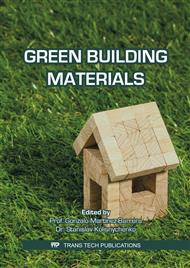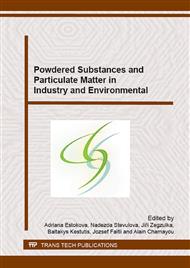[1]
O. Faruk, A.K. Bledzki, H.P. Fink, M. Sain., Biocomposites reinforced with natural fibres: 2000-2010, Progress in Polymer Science, 37 (2012) 1552-1596.
DOI: 10.1016/j.progpolymsci.2012.04.003
Google Scholar
[2]
J. Summerscales, N.P.J. Dissanayake, A.S. Virk, W. Hall, A review of bast fibres and their composites. Part 1 – Fibres as reinforcements, Composites Part A: Applied Science and Manufacturing, 41 (2010) 1329-1335.
DOI: 10.1016/j.compositesa.2010.06.001
Google Scholar
[3]
K.G. Satyanarayana, G.G.C. Arizaga, F. Wypych, Biodegradable composites based on lignocellulosic fibers – an overview, Progress in Polymer Science, 34 (2009) 982-1021.
DOI: 10.1016/j.progpolymsci.2008.12.002
Google Scholar
[4]
M.J. John, S. Thomas, Review – biofibres and biocomposites, Carbohydrate Polymers, 71 (2008) 343-364.
DOI: 10.1016/j.carbpol.2007.05.040
Google Scholar
[5]
S. Shinoja, R. Visvanathanb, S. Panigrahic, M. Kochubabua, Oil palm fiber (OPF) and its composites: a review, Industrial Crops and Products, 33 (2011) 7-22.
DOI: 10.1016/j.indcrop.2010.09.009
Google Scholar
[6]
A.K. Mohanty, M. Misra, G. Hinrichsen, Biofibers, biodegradable polymers and biocomposites: an overview, Macromolecular Materials and Engineering, 276 (2000) pp.1-24.
DOI: 10.1002/(sici)1439-2054(20000301)276:1<1::aid-mame1>3.0.co;2-w
Google Scholar
[7]
A.K. Bledzki, V.E. Sperber, O. Faruk, Natural and wood fibre reinforcements in polymers, Rapra Review Reports, 13 (2002) 1-144.
Google Scholar
[8]
A.K. Bledzki, J. Gassan, Composites reinforced with cellulose based fibres, Progress in Polymer Science, 24 (1999) 221-274.
DOI: 10.1016/s0079-6700(98)00018-5
Google Scholar
[9]
M. Le Troëdec, P. Dalmay, C. Patapy, C. Peyratout, C. Smith, D. Chotard, Mechanical properties of hemp-lime reinforced mortars: influence of the chemical treatments of fibers, J. Compos. Mater. 45 (2011) 2347-2357.
DOI: 10.1177/0021998311401088
Google Scholar
[10]
N. Stevulova, J. Cigasova, A. Estokova, E. Terpakova, A. Geffert, F. Kacik, E. Singovszka, M. Holub, Properties characterization of chemically modified hemp hurds, Materials, 7 (2014) 8131-8150.
DOI: 10.3390/ma7128131
Google Scholar
[11]
M.F. Rosa, E.S. Medeiros, J.A. Malmonge, K.S. Gregorski, D.F. Wood, L.H.C. Mattoso, S.H. Imam, Cellulose nanowhiskers from coconut husk fibers: Effect of preparation conditions on their thermal and morphological behavior, Carbohydrate Polymers, 81 (2010).
DOI: 10.1016/j.carbpol.2010.01.059
Google Scholar
[12]
J. Gassan, A. Chate, A.K. Bledzki, Calculation of elastic properties of natural fibers, Journal of Materials Science, 36 (2001) 3715-3720.
DOI: 10.1023/a:1017969615925
Google Scholar
[13]
J. Klemeš, P.S. Varbanov, D. Huisingh, Recent cleaner production advances in process monitoring and optimization, J. Cleaner Pro. 34 (2012) 1-8.
DOI: 10.1016/j.jclepro.2012.04.026
Google Scholar
[14]
P.B. de Bruijn, K.H. Jeppssona, K. Sandinb, Ch. Nilssona, Mechanical properties of lime–hemp concrete containing shives and fibres, Biosystems Engineering, 103 (2009) 474-479.
DOI: 10.1016/j.biosystemseng.2009.02.005
Google Scholar
[15]
A. Stikute, S. Kukle, G. Shakhmenko, Ecological materials for frame housing, Scientific Journal of Riga Technical University, Material Science. Textile and Clothing Technology, 6 (2011) 43-47.
Google Scholar
[16]
Z.N. Azwa, B.F. Yousif, A.C. Manalo, W. Karunasena, A review on the degradability of polymeric composites based on natural fibres, Materials and Design, 47 (2013) 424-442.
DOI: 10.1016/j.matdes.2012.11.025
Google Scholar
[17]
H. Savastano Jr., S.F. Santos, M. Radonjic, W.O. Soboyejo, Fracture and fatigue of natural fiber-reinforced cementitious composites, Cement and Concrete Composites, 31 (2009) 232-243.
DOI: 10.1016/j.cemconcomp.2009.02.006
Google Scholar
[18]
S. Elfordy, F. Lucas, F. Tancret, Y. Scudeller, L. Goudet, Mechanical and thermal properties of lime and hemp concrete (hempcrete, ) manufactured by a projection process, Construction Building Materials, 22 (2008) 2116-2123.
DOI: 10.1016/j.conbuildmat.2007.07.016
Google Scholar
[19]
I. Preikss, J. Skujans, A. Adamovics, U. Iljins, Evaluation of hemp (Cannabis Sativa L. ) quality parameters for building material from foam gypsum products, Chemical Engineering Transaction, 32 (2013) 1639-1643.
Google Scholar
[20]
L. Kidalova, N. Stevulova, E. Terpakova, A. Sicakova, Use of magnesium oxide-cement binder in composites based on hemp shives, Journal of Environmental Science and Engineering, 5 (2011) 736-741.
DOI: 10.1016/j.proeng.2013.09.013
Google Scholar
[21]
L. Kidalova, E. Terpakova, N. Stevulova, MgO cement as suitable conventional binder's replacement in hemp concrete, Pollack Periodica, 6 (2011) 107-112.
DOI: 10.1556/pollack.6.2011.3.11
Google Scholar
[22]
R. Brencis, J. Skujans, U. Iljins, I. Ziemelis, O. Osits, Research on foam gypsum with hemp fibrous reinforcement, Chemical Engineering Transaction, 25 (2011) 159-164.
Google Scholar
[23]
S.R. Karade, Cement-bonded composites from lignocellulosic wastes, Construction Building Materials, 24 (2010) 1323-1330.
DOI: 10.1016/j.conbuildmat.2010.02.003
Google Scholar
[24]
M. Tröedec, C. Peyratout, A. Smith, Influence of various chemical treatments on the interactions between hemp fibres and a lime matrix, Journal of the European Ceramic Society, 29 (2009) 1861-1868.
DOI: 10.1016/j.jeurceramsoc.2008.11.016
Google Scholar
[25]
M. Tröedec, P. Rachini, C. Peyratout, M. Rossignol, F. Kaftan, A. Smith, Influence of chemical treatments on adhesion properties of hemp fibres, Journal of Colloid and Interface Science, 356 (2011) 303-310.
DOI: 10.1016/j.jcis.2010.12.066
Google Scholar
[26]
A.B. Thomsen, A. Thygesen, V. Bohn, K.V. Nielsen, B. Allesen, M.S. Jorgensen, Effects of chemical and physical pre-treatment processes on hemp fibers for reinforcement of composites and for textiles, Ind. Crop. Prod. 24 (2006) 113-118.
DOI: 10.1016/j.indcrop.2005.10.003
Google Scholar
[27]
S. Renouard, Ch. Hano, J. Doussot, J.P. Blondeau, E. Lainé, Characterization of ultrasonic impact on coir, flax and hemp fibers, Materials Letters, 129 (2014) 137-141.
DOI: 10.1016/j.matlet.2014.05.018
Google Scholar
[28]
L. Kidalova, N. Stevulova, E. Terpakova, A. Sicakova, Utilization of alternative materials in lightweight composites, Journal of Cleaner Production, 34 (2012) 116-119.
DOI: 10.1016/j.jclepro.2012.01.031
Google Scholar
[29]
N. Stevulova, L. Kidalova, J. Junak, J. Cigasova, E. Terpakova, Effect of hemp shive sizes on mechanical properties of lightweight fibrous composites, Procedia Engineering, 42 (2012) 543-547.
DOI: 10.1016/j.proeng.2012.07.441
Google Scholar
[30]
J. Cigasova, N. Stevulova, J. Junak, Properties of monitoring of fibrous composites based on hemp hurds with different mean particle size, Pollack Periodica, 8 (2013) 41-46.
DOI: 10.1556/pollack.8.2013.2.5
Google Scholar
[31]
N. Stevulova, I. Schwarzova, Changes in the properties of composites caused by chemical treatment of hemp hurds, International Journal of Chemical, Biomolecular, Metallurgical, Materials Science and Engineering, 8 (2014) 363-367.
Google Scholar
[32]
J. Cigasova, N. Stevulova, J. Junak, Influence of binder nature on properties of lightweight composites based on hemp hurds, International Journal of Modern Manufacturing Technologies, 5 (2013) 27-31.
DOI: 10.1016/j.proeng.2013.09.013
Google Scholar
[33]
STN EN 206-1/A1 Concrete, Part 1, Specification, performance, production and conformity, (2009).
Google Scholar
[34]
STN EN 12087/A1 Thermal insulating products for building applications, (2007).
Google Scholar



